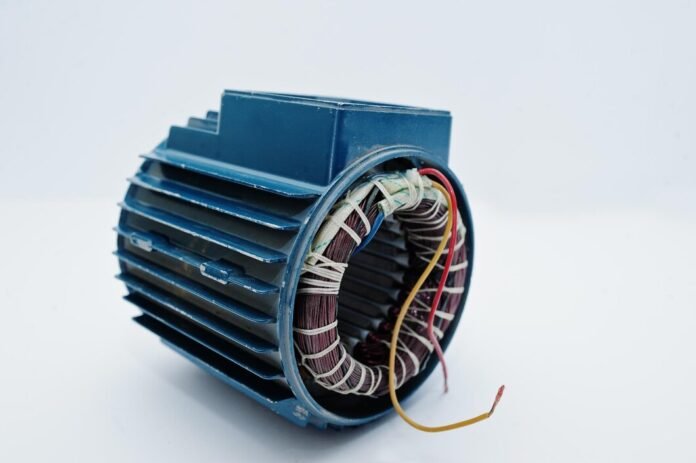Introduction
Electric Motors are machines that convert electrical energy to mechanical energy. Those motors can be mainly used in industries etc. These contain stators and rotors. We can now discuss how the motors are classified and what are the working motors and components of DC motors, and the difference between synchronous and induction motors.
Electric Motor
An electric motor is a motor that converts electrical energy into mechanical energy. Motors work on the principle of Faraday’s law.
Now let’s discuss the types of motors available.
Types of Motors
There are two kinds of electric motors:
1. AC Motor
2. DC Motor
There are two kinds of AC motors. They are synchronous motors and induction motors. Again, induction motors are divided into two types. They are the one-phase induction motor and the three-phase induction motor.
Let’s discuss each motor one by one. The first is an alternating current (AC) motor.
1. AC Motor:
The name “AC Motor” suggests that the motor is driven by an alternating current. It converts alternating current to mechanical energy. It is a constant-speed motor.
Examples of AC motors are synchronous motors and induction motors. AC motor contains a stator, stator core, stator slots, base plate, etc.
- Synchronous Motors:- These motors run at a constant speed and they will not start by themselves (not self-start). The formula for the synchronous speed is Ns = 120 f/P, where f is the frequency and P is the number of poles.
Working of Synchronous Motors:
Synchronous motors generally work with two electrical supplies namely a 3-phase supply on the stator and a DC supply on the rotor. At times, rotor and stator poles are repulsive to each other because they are facing north to north or south to south. After one second, they will attract each other because they are facing north to south poles. Because of these forces, they will be available in a constant position. It means there is no movement between them.
- Induction Motor: Nowadays, the most widely used motor is the squirrel cage induction motor. It is easy to find AC motors in applications namely compressors, machine Tools, etc.
AC Motors is divided into single-phase and polyphase motors. Here poly means multiple phases or three phases. The advantage of using 3-phase motors is efficiency. Examples of polyphase motors are Induction, Wound rotors, etc.
Components of an Induction Motor: The main parts present in the Induction motor are the rotor and stator. The rotor is the rotating element and it consists of copper bars that are connected at the end of the ring. It is filled with steel disks which are called laminations. The stator is the stationary element that generates magnetic flux.
In the previous section, we discussed AC motors. Now let’s gain some knowledge on DC Motors.
2. DC Motor:
DC motors are generally operated by direct current only. These are used mainly in automobiles, aircraft, portable electronics, etc. The main advantages of DC motors are speed and torque regulation. It is used in automobiles to charge their battery.
Basic Components of DC Motor:
The basic circuits present in DC Motor are armature and field. The armature is the device that rotates, sometimes which is referred to as a rotor. The field is the stationary part which is referred to as the stator.
The armature and the field are the two circuits that interact and then produce rotation in the armature. The armature contains an integral part known as a commutator. It acts as an electric switch.
Different Parts of DC Motor:
Different parts in DC Motor are Armature, Field, Commutator, Frame, Ball Bearing, etc.
Armature: Armature is also called the rotor. It is the magnetic lamination that is insulated to each other. It rotates on its axis.
Field coil: A field coil is also called a stator. It is a stationary part that produces a magnetic field.
Differences between Synchronous and Induction Motors:
Synchronous Motors:
1. It does not start itself.
3. Speed control is not possible.
4. Load increases with load angle while maintaining a constant speed.
5. Rotor needs more power supply.
6. It requires slip rings and windings to start the motor.
7. Speed of the motor is controlled by VFD.
8. Speed of the motor is Ns =120 f/P.
9. It is efficient and contains greater precision.
10. Operation is complicated.
Induction Motors:
1. It starts by itself.
3. Speed control is possible.
4. When a load increases, speed decreases.
5. No need for any extra power supply.
6. It does not require slip rings to start the motor.
7. Speed of the motor is controlled by rotor resistance as well as VFD.
8. Speed of the motor is N = Ns(1 – s), where s stands for slip.
N < Ns
9. It is not efficient.
10. Operation is easy and simple.
Recommended Articles:
What are the Types of Radiation?
Types of Rocks – Igneous, Sedimentary and Metamorphic
Types of Switches – Definition, Mechanical and Momentary Control
Types of Volcanoes Based on Frequency and Eruption
Types of Wind – Planetary, Periodic, Monsoon and Variable
An Electronic motor is a machine that converts electrical energy to mechanical energy. There are two main types of motors. These are AC motors and DC Motors. AC Motors are classified into two types. They are Synchronous motors and Induction motors. A motor that runs at a synchronous speed is called a synchronous motor. The components present in the induction motor are Rotor and Stator. A rotor is a rotating element whereas the stator is a stationary element. Types of Motors FAQs
What is an electronic motor?
What are the main types of motors?
What are the types of AC Motors?
What is a synchronous motor?
Name two components available in an induction motor and define them?
